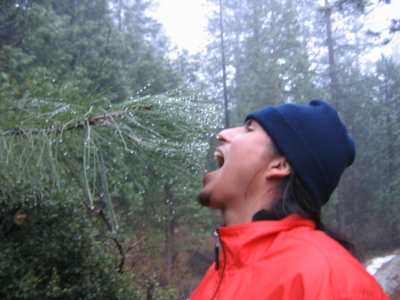as west as we will go
away from Punta Arenas. So far all is good, finally everyone including
me got used to the sea, i.e. no more seasickness around or at least only
minor effects. The waves have been a lot nicer compared to last week,
not more than 8 [m] :).
Among all the instruments that have been deployed during this cruise are:
XBT (eXpendable BathyThermograph ) they are pretty common during
any expedition, it provides a profile of Temperature as a function of
Depth (Pressure) and it is used to estimate the sound speed as a
function of the depth which is used to calibrate the sonars and all the
acoustic equipment on the ship. In this case we also use them to see
water fronts and also water-masses. I will think those are the simplest
of all of the instruments, by the way they are made by Lockheed Martin
and they do look like a big bullet so I guess now I found the first non
destructive bullet with a real application. They even have a pistol-like
to launch it. I have to admit that it is pretty anticlimactic
experience, this big heavy bullet coming from a pistol does not make
"boom" or any sound at all, it just falls on the side of the ship. It
has attached to it a really thin cable which transmits all the
information that is being collected on real time, once it passes it's
depth range one just need to cut the cable with the hand an that was it,
the bullet is lost in the ocean and a file with water properties is
saved on the computer.
XCTD (eXpandable Conductivity Temperature Depth), those are a little
more sofisticated than the previous but still give similar information,
Temperature, Conductivity and Depth. Conductivity is then used together
with temperature to estimate the Salinity, with Salinity, Temperature
and Depth (or Pressure) we could use the equation of state for sea water
and find the Density, which is a pretty useful quantity in Ocean
Sciences. For this specific cruise XCTD's are used to find possible
overturns on the water column, those overturns are related to mixing
potential. Thorpe's scale relates the size of those overturns to
turbulent mixing. Since this cruise is all about mixing there would be
some people that would look into that data.
Shear meters. This has been so far a unique deployment since it is a
test. There are 3 more on the main lab waiting for this one to work and
maybe also able to get some data from it. It was deployed for a 12-day
test mission and is expected to come back to the surface on 10 February
2010. If the test mission is successful, it would talk to us via
satellite and in the same way will delivered the collected data. It
would also be able to tell us if the sound source, moored days later, is
working
Sound Source Moorings. There are lots of moorings out there in the
Ocean, basically they are a quasi-vertical cable with lots of
instruments attached to it. The ones that were deployed during this
cruise have a huge battery (with a life spam of ~ 9 years) and a sound
source. Deploying Mooring instruments is quite the task, it takes a full
day and most of the people on shift to help with.
The morning started by gathering some big yellow balls that provide
buoyancy while the rest of the instruments are being added. Also, they
are the closest to the surface and are the ones that are thrown in the
water first, then some kilometers of cable, the battery followed by the
sound source, more cable and finally the most exciting part, release the
anchor, which for this case consisted on 4 train wheels (~680 pounds
each). When we were releasing them I kept thinking "stay away from the
chain, stay away from the chain.." I couldn't imagine falling on the
water next to the anchor.... ain't pretty!!!
Those sound sources ping twice a day, then there is an army of
instruments called RAFOS floats, they look like giant crystal chemistry
test tubes that have a weight attached to the bottom, this weight puts
them neutrally buoyant at a predetermined depth, they remained there for
a while following the currents and measuring temperature and some other
properties, they also listen to the sound sources and by triangulation,
the location of the floats is known. All those 101 floats were thrown
along the 105 W line and they will be there for more than a year, then
hopefully release the weight come up to the surface and release all the
information they have via satellite. Then they will remain floating and
drift as the surface currents wish. Just like the message bottles that
use to carry treasure maps, those huge long bottles have written on the
on many languages what they are and they also have an address where to
be sent to. Apparently they have gotten some of those back to WHOI,
which I think is quite nice to see them coming back home.
There are some other floats, I guess one could call them more skillful
EM-APEX, those come back up to the surface every 2 days or so on their
own and they also sink back down to where they are supposed to be
floating. I really want to mention, those are freaking heavy!!!
I guess this is enough for this summary, the other instruments will
continued to be used over the rest of the cruise, i.e. 4 more weeks!!!
We have seen so far 3 icebergs and the albatrosses keep following us,
most of the days have been pretty cloudy and rainy but today, Sunday
SuoperBawl day it is pretty sunny, cold but sunny and now we are heading
back east starting a new section that will go north almost for 2 days...
we are still looking for the tracer left in the area a year ago. So far
we found no tracer along the 105 W section, it seems all of it has been
drifted east from the release point.
my best wishes to all of you for this coming week, now we are officially
on our leap-frog-speed way back to port.
saludos!




0 Comments:
Post a Comment
<< Home